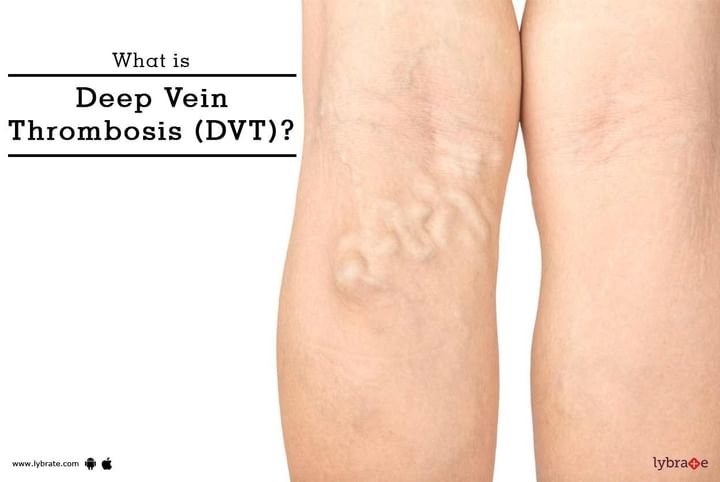What is Deep Vein Thrombosis (DVT) - Symptoms,Treatment & Prevention
What is Deep Vein Thrombosis?
Blood clots can arise anywhere in your body. They develop when blood thickens and clumps together. When a clot forms in a vein deep in the body, it's called Deep Vein Thrombosis (DVT). Deep vein blood clots typically occur in the lower leg or thigh. But if your symptoms stem from a blood clot deep in your leg, it can be dangerous. Blood clots can happen to anyone, anytime. But some people are at increased risk. Therefore, they should immediately consult with a vein specialists to avoid blood clots forming in the veins which can help avoid potentially serious problems.
Deep Vein Thrombosis (DVT) Symptoms
'Deep vein thrombosis has classic symptoms - for example, swelling, pain, warmth, and redness on the leg,' says Dr. Rajendra Bansal, a DVT treatment expert in Jaipur. “But about 30–40% of cases go unnoticed since they don't have typical symptoms.” In fact, some people don't realize they have a deep vein clot until it causes a more serious condition.
Deep Vein Clots
Deep Vein Thrombosis (DVT)symptoms include deep vein clots - especially those in the thigh - can break off and travel through the bloodstream. If a clot lodges in an artery in the lungs, it can block blood flow and lead to a sometimes-deadly condition called pulmonary embolism. This disorder can damage the lungs and reduce blood oxygen levels, which can harm other organs as well.
Some people are more at risk for deep vein thrombosis than others. 'Usually people who develop deep vein thrombosis have some level of thrombophilia, which means their blood clots more rapidly or easily,' Dr. Bansal says, a DVT specialist in Jaipur. Getting a blood clot is usually the first sign of this condition because it’s hard to notice otherwise. In these cases, lifestyle can contribute to a blood clot forming—if you don’t move enough, for example. Your risk is higher if you’ve recently had surgery or broken a bone if you’re ill and in bed for a long time, or if you're traveling for a long time (such as during long car or airplane rides).
Other Symptoms of Deep Vein Thrombosis (DVT)?
Having other diseases or conditions can also raise your chances of a blood clot. These include a stroke, paralysis (an inability to move), chronic heart disease, high blood pressure, surgical procedure, or having been recently treated for cancer. Women who take hormone therapy pills or birth control pills are pregnant, or within the first 6 weeks after giving birth are also at higher risk. So are those who smoke or who are older than 60. But deep vein thrombosis can happen at any age.
Chronic vs Acute Deep Vein Thrombosis (DVT)
Chronic Deep Vein Thrombosis refers to long-standing venous thrombosis present for more than 28 days. It can either permanently block the vein or it can adhere to the wall of the vein. Chronic DVT that doesn’t block the vein can still cause long-term problems known as Post Thrombotic syndrome which occurs due to pooling of blood in legs by gravity as the protective valves are damaged or destroyed. Patient symptoms are:
- Leg swelling after standing for long periods
- Aching pain
- Varicose veins
- Skin ulcers in severe cases.
Acute Deep Vein Thrombosis (DVT) refers to venous thrombosis for which symptoms have been present for 14 days or less. The symptoms of acute DVT are sudden limb swelling and pain. During this period the clot is soft and easily treated with clot-dissolving drugs. The period between 14-28 days is called Sub-acute DVT.
Clues of Deep Vein Thrombosis (DVT)?
Seek Deep Vein Thrombosis treatment if you have these symptoms. They may signal a deep vein clot or pulmonary embolism:
- Swelling of the leg or along a vein in the leg
- Pain or tenderness in the leg, which you may feel only when standing or walking
- Increase in warmth in the area of the leg that’s swollen or painful
- Red or discolored skin on the leg
- Unexplained shortness of breath
- Pain with deep breathing
- Coughing up blood
Prompt diagnosis and proper Deep Vein Thrombosis (DVT) treatment can help prevent the complications of blood clots. See your doctor immediately if you have any signs or symptoms of deep vein thrombosis or pulmonary embolism. A physical exam and other tests can help doctors determine whether you’ve got a blood clot.
Your doctor will diagnose deep vein thrombosis (DVT) based on your medical history, a physical exam, and the color Doppler ultrasound or sometime may require CT or MRI. He or she will identify your risk factors and rule out other causes of your symptoms. After analyzing the risk factors, the doctor will tell you whether you need an immediate DVT treatment or not.
Deep Vein Thrombosis (DVT) Treatment
There are many ways in Deep Vein Thrombosis treatment. DVT treatment process includes medicines, certain devices, and therapies. The main goals of DVT treatment include:
- Stopping the blood clot from getting bigger
- To dissolve the already formed clot
- Preventing the blood clot from breaking off and moving to your lungs
- Reducing your chance of having another blood clot
- To prevent long-term complications known as Post Thrombotic Syndrome.
Anticoagulants (Blood Thinners)
These are the most common medicines in Deep Vein Thrombosis (DVT) treatment. These medicines decrease your blood’s ability to clot. They also stop existing blood clots from getting bigger. However, blood thinners can’t break up blood clots that have already formed. (The body dissolves most blood clots with time.)
Blood thinners are taken either as a pill, an injection under the skin or through a needle or tube inserts into a vein (called intravenous or IV injection). There are different types of Blood thinner. The choice of anticoagulant depends upon multiple factors, including the preference of the patient and the healthcare provider, the patient’s medical history and other conditions, and cost considerations.
Initial anticoagulation is continued for 5 to 10 days. After that, long-term anticoagulation is continued for 3 to 12 months depending upon the patient profile, length of vessel involvement, and risk of recurrence. In some patients where permanent risk factors like a congenital cause or cancer lifelong anticoagulation may require.
Other available treatments, which are for specific situations, include thrombolytic therapy or placing a filter in a major blood vessel (the inferior vena cava).
Thrombolysis (Clot-Busting DVT Treatment)
Minimally invasive procedures in DVT treatment are performed by an interventional radiologist under X-ray Guidance if a patient has severe pain, difficulty in walking, significant swelling while on blood thinners, or if there is clot blocking the pelvic veins (iliac veins). When performed early, thrombolysis is highly effective at dissolving a clot and preserving the valves in the veins.
It is designed to rapidly break up the clot, restore blood flow within the vein, and potentially preserve valve function to minimize the risk of post-thrombotic syndrome. The interventional radiologist inserts a tiny tube called a catheter into the vein behind the knee or other leg vein and threads it into the vein containing the clot using x-ray guidance.
The catheter tip is placed into the clot and a “clot-busting” drug is infused directly to the thrombus (clot) followed by clot removal by special devices. The fresher the clot, the faster it dissolves – one to two days. Clinical resolution of pain and swelling and restoration of blood flow in the vein is greater than 85 percent with these invasive techniques.
In patients in whom thrombolysis or blood thinners are not medically appropriate, an interventional radiologist can insert a vena cava filter, a small device that functions as an umbrella to capture blood clots that would float to the lung, but allows normal liquid blood to pass.
DEEP VEIN THROMBOSIS PREVENTION
You can take simple steps to lower your chances for a blood clot:
- Exercise your lower leg muscles if you’re sitting for a long time while traveling.
- Get out of bed and move around as soon as you’re able after having surgery or being ill.
- The more active you are, the better your chance of avoiding a blood clot.
- Take any medicines your doctor prescribes to prevent clots after some types of surgery.
- Wear compression stocking to prevent complications or recurrence as per instruction.
- Keep a regular follow-up with your doctor to avoid or prevent post DVT complications.
SPECIAL PRECAUTIONS FOR PEOPLE WITH DEEP VEIN THROMBOSIS:
- Patients being treated for venous thrombosis are at an increased risk for developing another blood clot. The patient should watch for new-onset leg pain or swelling. If these symptoms occur, the patient should speak to his/her health care provider or seek medical attention as soon as possible.
- The risk of bleeding is high with anticoagulants so the dose should not change unless the provider or clinic directs the patient to do so.
Patients may bleed easily from anywhere while taking anticoagulants. In some cases, bleeding can develop inside the body and can’t notice immediately. Bleeding inside the body can cause a person to feel faint, or have pain in the back or abdomen. A healthcare provider should be notified immediately if there is any sign of this problem.
Update From Lybrate: Buy Vitamins and Supplements from Lybrate’s Goodkart and keep your metabolic activities on track. These essential vitamins provide energy, strengthens bone health, and repair cellular damage.



+1.svg)
